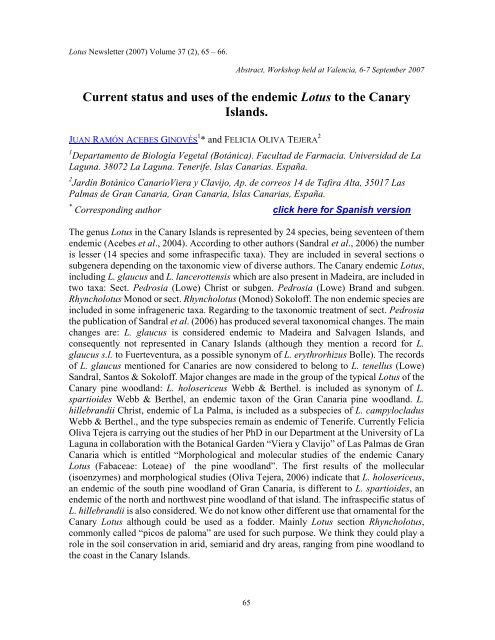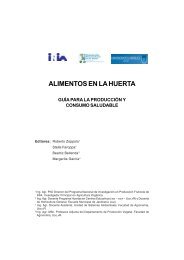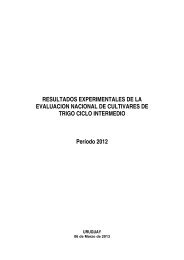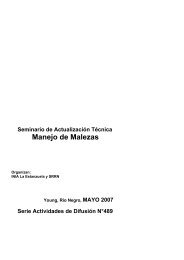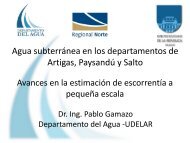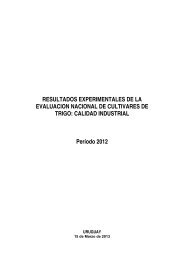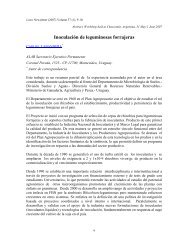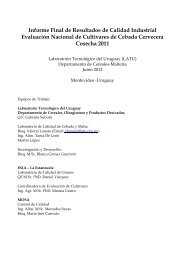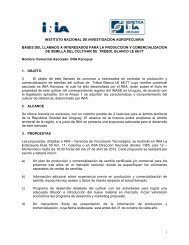Current status and uses of the endemic Lotus to the Canary ... - Inia
Current status and uses of the endemic Lotus to the Canary ... - Inia
Current status and uses of the endemic Lotus to the Canary ... - Inia
You also want an ePaper? Increase the reach of your titles
YUMPU automatically turns print PDFs into web optimized ePapers that Google loves.
<strong>Lotus</strong> Newsletter (2007) Volume 37 (2), 65 – 66.<br />
Abstract, Workshop held at Valencia, 6-7 September 2007<br />
<strong>Current</strong> <strong>status</strong> <strong>and</strong> <strong>uses</strong> <strong>of</strong> <strong>the</strong> <strong>endemic</strong> <strong>Lotus</strong> <strong>to</strong> <strong>the</strong> <strong>Canary</strong><br />
Isl<strong>and</strong>s.<br />
JUAN RAMÓN ACEBES GINOVÉS 1 * <strong>and</strong> FELICIA OLIVA TEJERA 2<br />
1 Departamen<strong>to</strong> de Biología Vegetal (Botánica). Facultad de Farmacia. Universidad de La<br />
Laguna. 38072 La Laguna. Tenerife. Islas Canarias. España.<br />
2 Jardín Botánico CanarioViera y Clavijo, Ap. de correos 14 de Tafira Alta, 35017 Las<br />
Palmas de Gran Canaria, Gran Canaria, Islas Canarias, España.<br />
* Corresponding author click here for Spanish version<br />
The genus <strong>Lotus</strong> in <strong>the</strong> <strong>Canary</strong> Isl<strong>and</strong>s is represented by 24 species, being seventeen <strong>of</strong> <strong>the</strong>m<br />
<strong>endemic</strong> (Acebes et al., 2004). According <strong>to</strong> o<strong>the</strong>r authors (S<strong>and</strong>ral et al., 2006) <strong>the</strong> number<br />
is lesser (14 species <strong>and</strong> some infraspecific taxa). They are included in several sections o<br />
subgenera depending on <strong>the</strong> taxonomic view <strong>of</strong> diverse authors. The <strong>Canary</strong> <strong>endemic</strong> <strong>Lotus</strong>,<br />
including L. glaucus <strong>and</strong> L. lancerottensis which are also present in Madeira, are included in<br />
two taxa: Sect. Pedrosia (Lowe) Christ or subgen. Pedrosia (Lowe) Br<strong>and</strong> <strong>and</strong> subgen.<br />
Rhyncholotus Monod or sect. Rhyncholotus (Monod) Sokol<strong>of</strong>f. The non <strong>endemic</strong> species are<br />
included in some infrageneric taxa. Regarding <strong>to</strong> <strong>the</strong> taxonomic treatment <strong>of</strong> sect. Pedrosia<br />
<strong>the</strong> publication <strong>of</strong> S<strong>and</strong>ral et al. (2006) has produced several taxonomical changes. The main<br />
changes are: L. glaucus is considered <strong>endemic</strong> <strong>to</strong> Madeira <strong>and</strong> Salvagen Isl<strong>and</strong>s, <strong>and</strong><br />
consequently not represented in <strong>Canary</strong> Isl<strong>and</strong>s (although <strong>the</strong>y mention a record for L.<br />
glaucus s.l. <strong>to</strong> Fuerteventura, as a possible synonym <strong>of</strong> L. erythrorhizus Bolle). The records<br />
<strong>of</strong> L. glaucus mentioned for Canaries are now considered <strong>to</strong> belong <strong>to</strong> L. tenellus (Lowe)<br />
S<strong>and</strong>ral, San<strong>to</strong>s & Sokol<strong>of</strong>f. Major changes are made in <strong>the</strong> group <strong>of</strong> <strong>the</strong> typical <strong>Lotus</strong> <strong>of</strong> <strong>the</strong><br />
<strong>Canary</strong> pine woodl<strong>and</strong>: L. holosericeus Webb & Ber<strong>the</strong>l. is included as synonym <strong>of</strong> L.<br />
spartioides Webb & Ber<strong>the</strong>l, an <strong>endemic</strong> taxon <strong>of</strong> <strong>the</strong> Gran Canaria pine woodl<strong>and</strong>. L.<br />
hillebr<strong>and</strong>ii Christ, <strong>endemic</strong> <strong>of</strong> La Palma, is included as a subspecies <strong>of</strong> L. campylocladus<br />
Webb & Ber<strong>the</strong>l., <strong>and</strong> <strong>the</strong> type subspecies remain as <strong>endemic</strong> <strong>of</strong> Tenerife. <strong>Current</strong>ly Felicia<br />
Oliva Tejera is carrying out <strong>the</strong> studies <strong>of</strong> her PhD in our Department at <strong>the</strong> University <strong>of</strong> La<br />
Laguna in collaboration with <strong>the</strong> Botanical Garden “Viera y Clavijo” <strong>of</strong> Las Palmas de Gran<br />
Canaria which is entitled “Morphological <strong>and</strong> molecular studies <strong>of</strong> <strong>the</strong> <strong>endemic</strong> <strong>Canary</strong><br />
<strong>Lotus</strong> (Fabaceae: Loteae) <strong>of</strong> <strong>the</strong> pine woodl<strong>and</strong>”. The first results <strong>of</strong> <strong>the</strong> mollecular<br />
(isoenzymes) <strong>and</strong> morphological studies (Oliva Tejera, 2006) indicate that L. holosericeus,<br />
an <strong>endemic</strong> <strong>of</strong> <strong>the</strong> south pine woodl<strong>and</strong> <strong>of</strong> Gran Canaria, is different <strong>to</strong> L. spartioides, an<br />
<strong>endemic</strong> <strong>of</strong> <strong>the</strong> north <strong>and</strong> northwest pine woodl<strong>and</strong> <strong>of</strong> that isl<strong>and</strong>. The infraspecific <strong>status</strong> <strong>of</strong><br />
L. hillebr<strong>and</strong>ii is also considered. We do not know o<strong>the</strong>r different use that ornamental for <strong>the</strong><br />
<strong>Canary</strong> <strong>Lotus</strong> although could be used as a fodder. Mainly <strong>Lotus</strong> section Rhyncholotus,<br />
commonly called “picos de paloma” are used for such purpose. We think <strong>the</strong>y could play a<br />
role in <strong>the</strong> soil conservation in arid, semiarid <strong>and</strong> dry areas, ranging from pine woodl<strong>and</strong> <strong>to</strong><br />
<strong>the</strong> coast in <strong>the</strong> <strong>Canary</strong> Isl<strong>and</strong>s.<br />
65
66 J.R. Acebes Ginoves <strong>and</strong> F. Oliva Tejera<br />
References<br />
ACEBES GINOVÉS J.R., ARCO AGUILAR M. DEL, GARCÍA GALLO A., LEÓN ARENCIBIA<br />
M.C., PÉREZ DE PAZ P.L., RODRÍGUEZ DELGADO O., WILDPRET DE LA TORRE W.,<br />
MARTÍN OSORIO V.E., MARRERO GÓMEZ M.C. <strong>and</strong> RODRÍGUEZ NAVARRO M.L..<br />
2004. División Sperma<strong>to</strong>phyta. In IZQUIERDO I., MARTÍN J.L, ZURITA N. <strong>and</strong><br />
ARECHAVALETA M. (eds.) Lista de especies silvestres de Canarias (hongos, plantas y<br />
animales terrestres) 2004. Consejería de Política Terri<strong>to</strong>rial y Medio Ambiente.<br />
Gobierno de Canarias. p: 99-140.<br />
OLIVA-TEJERA F., CAUJAPÉ-CASTELLS J., NARANJO-SUÁREZ J., NAVARRO-DÉNIZ J.,<br />
ACEBES-GINOVÉS J.R. <strong>and</strong> BRAMWELL D. 2005. Population genetic differentiation in<br />
<strong>the</strong> taxa <strong>of</strong> <strong>Lotus</strong> (Fabaceae: Loteae) <strong>endemic</strong> from <strong>the</strong> Gran Canarian pine forest.<br />
Heredity, 94(2), 199-206<br />
OLIVA-TEJERA F., CAUJAPÉ-CASTELLS J.J., NAVARRO-DÉNIZ J., REYES-BETANCORT A.,<br />
SCHOLTZ S., BACCARANI-ROSAS M. <strong>and</strong> CABRERA-GARCÍA N. 2006. Patterns <strong>of</strong><br />
genetic divergence <strong>of</strong> three Canarian <strong>endemic</strong> <strong>Lotus</strong> (Fabaceae:) : implications for <strong>the</strong><br />
conservation <strong>of</strong> <strong>the</strong> endangered L. Kunkelii. American Journal <strong>of</strong> Botany, 93(8),<br />
1116-1124.<br />
SANDRAL G., REMIZOWA M.V. <strong>and</strong> SOKOLOFF D. 2006. A taxonomic survet <strong>of</strong> <strong>Lotus</strong><br />
section Pedrosia (Leguminosae, Loteae). Wulfenia 13: 97-102.


